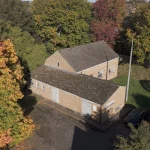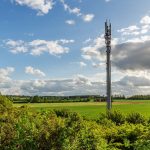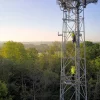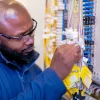When You’re Covered, But Not Covered, by Full Fibre Broadband

The excitement is palpable. You’ve just been told that a UK network operator has deployed a Fibre-to-the-Premises (FTTP) broadband ISP network down your road and made it live, only to then suffer the bitter pill of disappointment when you discover that your house is one of the few that can’t get it. But why? We take a look.
Most digital infrastructure builders tend to rollout new fibre along streets or lanes, which will typically be run to a nearby telegraph pole (overground deployment) or via lateral cuts to a Toby Box in the pavement (underground deployment) – usually just outside your home. The fibre optic cable is then only deployed to your house (aka – the “final drop“) once an order has been made for the service to be installed.
However, it’s at this point that problems sometimes creep into the process, which can result in homes being perhaps unfairly excluded from the local network coverage – either due to the limitations of the operator’s local deployment, or by choice of the homeowner themselves. Experiences will vary between locations, since deployment methods differ between operators and each area will have its own unique challenges.
Advertisement
Nevertheless, if you’ve been waiting years for such an upgrade, to suddenly find that what was promised is now not going to be available to you can be extremely disheartening. Thanks to feedback from both consumers, retail ISPs and network builders, we’ve been able to put together a short unordered list to highlight some of the reasons why homes may end up being excluded like this – despite the network being present on your street.
Reasons
➤ Database Errors
Sometimes the issue can be as deceptively simple as a database error, which may fail to register the existence of your property in the area. Similarly, if your house is a new build property, then it can sometimes take a few months before the online ordering systems provided by an ISP are able to recognise the fact that your house is even present.
There are also occasions when you might see multiple results for a single address, for example a house that has been converted into flats or one where land has recently been partitioned between several properties, which can cause problems.
Often issues like this can be resolved with a quick phone call to the ISP or some nudging of Royal Mail (here), although getting around the “computer says no” brigade of front-line support doesn’t always make this easy.
➤ Your distance from the street is too great
Most of us live in houses that are situated very close to the road, usually within a handful of metres, but the same is not true for everybody. Sometimes people live in houses that can be set quite far back from the road, which is more common in rural areas (e.g. farms), but can also apply in some quirkily designed suburban locations.
In short, we’ve seen a few cases where houses reach the street via an extremely long driveway, while the house itself may be set back 100 metres or more from the road where the fibre has been run. Often this will fall outside the operator’s ability to reach you via a standard installation approach, and so the property may be excluded from availability.
However, it is sometimes possible to talk directly with the operator about solving this, but doing so may require the property owner to pay Excess Construction Charges (ECC) to run the fibre over a much longer distance. In some cases, that might cost you several thousand pounds. But in other cases, the operator may not even be able to offer that as a solution.
Despite all this, experiences do vary and some operators will go to great lengths in order to reach difficult homes.
➤ No clear cable run from a pole (telecoms pole)
A lot of alternative network operators like to make use of new or existing telecoms (telegraph) poles to run their fibre, but in a given street there can sometimes be a situation where specific premises may not be reachable via poles due to the lack of a clear cable run to the house.
Since resolving this particular issue for individual properties may require more expensive civil engineering work (e.g. trenching or the deployment of several new poles), then the operator may simply opt to save money by removing the affected house (or houses) from their availability checker. Issues like this can cause a lot of confusion for consumers, but they are becoming more frequent as networks grow.
➤ Lack of an infrastructure sharing agreement
Some network operators will, wherever viable, try to make use of existing electricity poles or other infrastructure to run their fibre into homes. But in some streets, or part of a street, this may not be possible if the operator has been unable to secure the necessary permissions from the local power company (note: special training is often required before an operator’s engineers can even work on electricity poles).
Securing such access agreements can take a long time, but are preferable to more costly civil engineering. But this may thus temporarily create a patch-work of network availability in some locations until resolved. In other cases, there may be a lack of space for new kit on electricity poles, such as due to the complexity of a particular pole or existing infrastructure sharing agreements with rival operators (e.g. Openreach), which can be harder to resolve without the costly deployment of new poles etc.
We should add that electricity companies, and indeed many other infrastructure providers (except Openreach), are under no hard legal obligation to share access to their infrastructure with fibre builders.
➤ Lack of spare pole / port capacity
Sometimes all of the right infrastructure might be present to serve an area, but the network operator may not be able to offer the service to new customers because their network has run out of spare port capacity to add lines. For example, we’ve seen plenty of cases here Openreach has filled up all the ports on their pole or underground based Connectorised Block Terminals (CBT) – example.
Resolving issues like this can take time because there are often key limitations involved, such as in terms of how much loading capacity you can place on a pole, which might require the deployment of new poles or more trenching work. At present it doesn’t help that many broadband ISPs aren’t very effective at explaining to consumers when this is the cause of their local availability problems, despite the network itself being present.
➤ Conflicts over land ownership
Some houses are situated in such an awkward position of land ownership and division – between public and private property – that it can be difficult for operators to reach them with a new cable, without first crossing somebody else’s land, which may or may not be solvable via a wayleave agreement.
For example, we’ve seen situations where, in order to connect one house, it is necessary to run a new cable across or under the property of your neighbour, which is naturally something that they may reject if it is perceived as being likely to damage or disrupts their land (a fair concern). Once again, this is an issue where finding a solution can be difficult, but being on friendly terms with the people next door is a good start.
➤ Tree Preservation Orders (TPO)
Some houses may require a new cable to run near a tree with a TPO, which could block overhead cable delivery from poles and may attract tedious / expensive wayleaves if going underground. Situations like this may also require an additional survey and all of this is likely to take extra care and time to resolve.
➤ Flats – access and other restrictions
Many people live in large residential blocks of flats (Multi-Dwelling Units), but operators that want to extend their fibre into such buildings sometimes run into problems with access (i.e. securing wayleave agreements) or face obstacles to the physical build itself.
The law has recently been changed to make it easier for operators to access MDUs, even if landlords prove obstructive, but sometimes they will still find it particularly difficult to actually run their cables through the building (retrofits are always tricky, but solutions like InvisiLight do exist).
Issues of ‘Health and Safety’ may also crop up along the way and, in another example we’ve seen, an operator (here) once declined to fit a four-story building because it was simply deemed “too tall“. The annoying part is that consumers often don’t find out about these issues until the day of the first installations, which is usually after you’ve placed your order.
We covered all this a bit more in another related article (here).
➤ Split availability between ISPs
Some alternative network operators typically build an open-access wholesale network for other ISPs use. But on larger network builds this can sometimes result in a degree of split availability. The most common example of this comes from providers on Cityfibre’s network, where network availability at a local level can sometimes vary between ISPs.
For example, some providers, such as Vodafone, TalkTalk, Zen Internet and Giganet, are either available or almost available across the entirety of Cityfibre’s network. Meanwhile, other providers may have patchy availability and initially only sell to specific locations within the overall infrastructure coverage.
The reasons for this are often two-fold, relating to both a legacy of past exclusivity agreements and the costly challenge ISPs face when adapting to a new network operator in a different area. Independent ISPs have to invest in order to properly connect their network to the new infrastructure in each area (e.g. last May 2022 Giganet announced that they’d achieve national availability on Cityfibre within the next 12-months).
The problem with this is that regular consumers may pick an ISP on Cityfibre’s network, often after being told that the service has gone live (e.g. usually via emails, news articles or mailshots from Cityfibre), only to find that their chosen provider doesn’t yet serve the area. At this point the customer may incorrectly assume that the network is not yet live, when in fact they might still be able to order, just via a different ISP.
As if that confusion wasn’t bad enough then some ISPs don’t help by making it seem like their service is available to locations where it has yet to go live. The customer thus ends up placing an order, which is really more of a pre-order and one that comes attached to a vague or unreliable expectation of future service delivery. The ISP may then string the customer along by claiming that Cityfibre isn’t yet live, when in fact it might be if they’d just chosen a different ISP. We’ve experienced this ourselves with family members in different locations.
➤ Low-voltage cables and other obstacles
Various other obstacles could also prevent new fibre being run to your property. For example, we have heard of some cases where a network operator declined to provide the service because there was an overhead low-voltage power cable that would be in close proximity to the new fibre run between a pole and the property. Sometimes there are ways around this, but it often depends on how much cost the solution adds.
The list above is by no means exhaustive, but it does summarise some of the issues that we’ve seen highlighted in the real-world over the past 3-4 years. As full fibre networks continue to expand, then there’s every reason to believe that we’ll be seeing more issues like this in the future, not less.
In addition, an issue that affects one operator may also impact others, which can sometimes result in ‘patches’ or ‘islands’ of poor connectivity inside otherwise well covered areas. This is particularly true where cost conscious commercial builds are involved, since the operator may not feel incentivised enough to resolve a costly issue, particularly when that issue only impacts a few homes.
However, it is important to stress that not all operators react the same way to the issues above. Some operators are more effective at finding solutions to difficult problems, while others may be so cost or risk sensitive as to skip a property at the first sign of a problem.
Advertisement
Mark is a professional technology writer, IT consultant and computer engineer from Dorset (England), he also founded ISPreview in 1999 and enjoys analysing the latest telecoms and broadband developments. Find me on X (Twitter), Mastodon, Facebook, BlueSky, Threads.net and Linkedin.
« UK Set Ambition to Deliver Standalone 5G to All Populated Areas by 2030





















































I’ve an Openreach FTTP connection in rural Co. Tyrone. It’s just a 40/10 FTTP service supplied by Aquiss via Openreach back in August – I don’t absolutely need hyperfast speeds for my own needs, but I joined Aquiss as they had a six month 1/2 price offer, offered directly a 40/10 profile & had a 12 month only contract – the last two a combo I seen no one else promote, so I went with it to move on from an FTTC line that had often been plagued by (by the end, permanent) noise on the line that I couldn’t detect myself where the offender was other than to say that it wasn’t coming from my home or my immediate neighbours, not to mention that I was planning to upgrade my internal network wiring and getting FTTP in via Openreach would help future-proof things. Besides, the future is optical fibre.
Overall I’ve had no problems with Aquiss’ service though I’ll probably leave them at the end of the contract as some better offers are out there outside of their introductory offer – no complaints otherwise. However, ever since I’ve had FTTP installed, I do occasionally check to see if other Openreach-based ISPs are able to offer me a “full fibre” service when they claim they can do so, and guess what? Not all do. Two notable offenders are TalkTalk & 1p Broadband, whom both say they offer full fibre packages via Openreach yet when I put my details in their service checkers only come up with FTTC packages, or for some reason at least offering nothing better than 80/20. Also for some other ISPs like EE & Co-op broadband, they offer 40/10 & 80/20 profile packages at my address though they don’t state wherever delivery is by FTTC or FTTP. I’ve no future interest in FTTC, and I’d prefer if such ISPs would say what they use to sell their service to me!
I suspect the issue for me is that while by copper pair to my home has essentially no service no since I cancelled my FTTC service, there is still a DC voltage & dial tone when I plug a corded phone into the NTE5 socket! Dialling 17070 gives a phone number that when I try to call from a mobile, it doesn’t connect. I’m guessing this is feeding back to some ISPs that I (still) have a capable FTTC line to the premises even though there is a live FTTP connection, and offers FTTC by default for whatever reason?
From reading the above article, I suspect that several different issues emerge as to why my address gives several different, sometimes incomplete answers. As it is, Fibrus are able to serve my address and if they maintain their current offers by the time my current FTTP contract ends in August, I might switch over – I don’t *need* their baseline 150 Mb/s download speed, but at £20 pm guaranteed at that price for 24 months, it’s an offer not easy to dismiss.
1p is a subsidiary of utility warehouse who I believe use the Talk Talk network. I suspect the availability issue is more down to the talk talk than anything else
Talktalk have their own backhaul network, which interconnects at the larger Openreach “head-end” exchanges to pick up FTTC and FTTP traffic.
If they don’t have FTTP interconnects at your head-end exchange – or insufficient capacity – then either FTTP won’t be offered at all, or only at slower speeds.
Eventually though, they are likely to upgrade those interconnects. Northern Ireland is in the fortunate position of having something like 80%+ FTTP coverage already, so to serve the region properly, they’ll need the proper interconnects.
Smaller providers either use BT Wholesale’s backhaul network or buy from multiple backhaul networks, which is why they can serve a larger footprint of Openreach FTTP.
Just out of interest, I checked with both TalkTalk & 1pBroadband about getting service to a family member not far from me that moved into a new build less than three years ago and where Openreach only provided a FTTP line (no copper pair). The results were…
* TalkTalk – Fibre 65 & Fibre 150 available.
* 1pBroadband – no service provided.
…just to add, I though the Co-Op broadband was also served via TalkTalk’s network backbone, yet they’re able to offer me an FTTP 150 Mb/s service?
It all seems a little pot luck as to wherever an ISP is willing to serve me.
I have this problem.
I moved to a new house this week. The postcode has full fiber but my address dose not.
Next door is 1m away from mine. Same pole. Full fiber.
Openreach said the package off work to connect me started last month. But they give almost no timeline.
I fear I’m going to be trapped in this no fibre island too.
The last 5 homes in my street are connected to a pole across the street that connects to a cab ~1.5km away, all other homes connect to a cab on our street that is ~150m away from us.
Toob have been busy digging holes and their fibre infrastructure contractors have been busy running fibre to existing poles, it’s obvious which ones have been done as the fibre is rolled in a loop and taped to the side of the pole awaiting the next phase.
The pole across the road that my house is attached to does not have said fibre cable rolled up and taped to, neither does another pole a little further down the street that is hiding among some trees on a verge. That 2nd pole has an obvious draw string at its base so should be relatively straight forward to pull fibre to, that 1st pole across the street is 2 meters from a main chamber, and although I can’t see a draw string I can’t imagine it’d be hard to pull a cable up their too.
Toob have been doing the works in the area for 6 months now and we’ve gone through the disruptions of closed pavements, temp traffic lights and works at night where they are lifting covers in the street to blow fibre or clean the ducts.
I occasionally have my driveways blocked as there is a chamber right in front of my house that all comms providers access from time to time.
Walking or driving past pole after pole and seeing the rolled up fibre then seeing it missing from my closest poles does make me feel apprehensious.
I just know when I contact them I’ll get the normal brush off and no one will look at it and then when I eventually order they won’t want to add fibre to the poles as their teams have moved on to other areas and it’ll be too costly for them.
Crossing fingers in anticipation, but knowing my luck I’m going to be disappointed.
Possible that the duct to your pole is from the other cabinet which has not been built by TOOB yet, your street could be fed by to Secondary Nodes or Primary Nodes, hence the incomplete works.
Have you tried reaching out to TOOB to confirm if your properties will actually be serviced by their build?
That is a very real possibility but they’ve been trenching to existing poles and installing their own small tall cabinets which indicates local connectivity from their own cabs rather than off to a BT cab.
Adding these two which I have seen few times:
1) Damaged pole means Altnets can’t add any infrastructure until Openreach replaces the pole
2) metal poles do not allow Altnets to fit their equipment at the top like wood telegraph poles do
All in all the government should build a database of all these houses and their addresses since clearly this has an impact of their residents ability to have good internet connectivity.
This database would constantly be changed as each network builder adds their own networks to the streets. Who would pick up the bill to maintain this?
They do add kit to metal poles. CityFibre have done it to several near me.
They add a ring to attach the drop cables and a CBT to the top.
Add in AltNets that have limited build plans and/or will wait for Openreach to build first.
OPENREACH roll out very slow. They managed to install one telephone pole on my street and left rest.
Nothing blocking them install because Community fibre bring fibre entirely full street.
I have emailed them and got template reply stating will complete 2026.
I have contact my MP and she wrote to executive level and now they start to reply properly and they are investigating why rest of the street left out.
Another problem is most internet providers websites don’t tell you which network provider they will use to deliver your service. For example our house already has the Openreach fibre ONT installed but Cityfibre are also present in the street outside. If I was to order service from a provider e.g. Zen or Giganet who are live on both Openreach and Cityfibre, how does the customer know whether their new ISP will re-use the existing Openreach ONT or whether they will ask Cityfibre to run their own fibre to the property resulting in 2 holes in the customer’s house wall and 2 ONT’s installed?
Our Scout Hall is on a residential street. OR show fibre FTTP coming soon for our neighbours and FTTC available now and ADSL available. Our building shows as FTTP unavailable full stop, nothing else.
BT retail have said ADSL is actually available, even though OR does not show.
So when OR do install fibre, will it only cover those with FTTC connections on that pole or those with ADSL or those postcodes with addresses on the Royal Mail database…….
Openreach do not provide ADSL services which is why their site does not quote for ADSL .
Quite what properties will be covered in your locale is anyone’s guess. They tend to build according to the existing network topology, so they will tend to cover all properties that are connected to a particular cabinet and distribution points. In some circumstances they may omit some properties where there are specific issues.
Yep. Got the exact problem where my driveway excludes me from getting connected by Virgin.
I have a termination point with fibre optic cables (couple of blue cables) inside it right at the bottom of my drive. My drive is about 60m away from the main gate, which is then about a further 13m from the house.
Everything is our land, but Virgin don’t have my specific address as enabled for service because of this.
I’ve tried reaching out to them on a few occasions. Before they got rid of the team that would come out and do a site check I had a really nice guy tell me that if I dug a trench they’d activate it for me but the team got canned before I could do anything.
One aspect you have not covered in your article is the old political boundaries which defined what exchange you were connected to. I live in a house which forms a group of 4 houses immediately outside a city boundary. I can see all the city properties are served by full fibre and we are not despite the fact that it is on the same street and the properties are adjacent to each other.
Our exchange is several kilometers away and it is not in the current openreach plans to provide fibre service.
I would have thought the current IP ohones negated the need to be connected to your local exchange and despite requesting this Openreach appears to be blind to this simple fact. It would be really cost effective to connect out properties to the city excchange rather than laying 2 lilometers of fibre across the fields.
The city exchange is probably where any FTTC goes and FTTP will go to the same exchange. 4 out of 5 exchanges will be closed in the not too distant future.
If you phone an isp and speak to a human in the UK you can request a “New Line” you’ll need to explain that you don’t want to use the existing line and you want to pay for a new line to the alternate cab/exchange.
They’ll need to engage openreach to do a survey, hopefully they will speak with you during that survey otherwise they’ll plan to reuse the existing line.
I have a similar issue where my cab is over a km away yet there is a cab less than 200m down the road.
I contacted openreach via email and they recommended the new line approach. I then phoned plusnet and had to get transferred 3 or 4 times until someone vaguely understood what I was after, then I had multiple openreach appointments where they’d arrive, and I’d ask if they are installing a new line to the closer cab and they’d say it wasn’t on their job card and go.
After ~6 weeks I gave up. I wish I had persevered.
My line is connected to a pole across the road, but there is a pole at the end of my drive that is used to connect my neighbour to the same pole across the road. A few engineers had said it was possible to use that pole to connect to the other poles actually on my street but will need to see it actually happen.
‘I then phoned plusnet…’
Yeah that was unlikely to go well. They have no idea what you’re actually after. If you’re happy to pay the network rearrangement fee you will hopefully be okay paying more for an ISP that can get you what you want from Openreach.
I’m in a ‘hole’ in our town about 150m across. The checker says these premises will never get FTTP. They’re in a reasonably normal housing estate, none of the cases in the article apply. It’s such a small area half the houses in the postcode are live, and half are in ‘no plans’, with nothing obvious changing at the demarcation line.
BT of course won’t even reply to questions as to what the problem is..
Hassle local politicians to ask Openreach. Start with your local councillors, if no result then (if a two tier system) then escalate to county councillor, and then the MP. Openreach will generally not engage much with individuals simply because they’re not a customer facing company but they’re more inclined to respond to politicians because failure to do so is generally a bad thing.
It is quite common for BT poles to also have street lights on them. Usually not a problem in these cases. Where it tends to be a problem is where poles are used to distribute power at low voltage typically 600V to 35KV
DNO poles maybe, not Bt ( Openreach) poles
Openreach want to charge me over £2000 for 43m of ducting. The really annoying thing is that it’s only 20m to my house, the extra bit is to next door, who haven’t ordered FTTP but Openreach think it’s more cost effective to do that work now, and that I should pay for it!
Plusnet agree this is bonkers but don’t seem to be able to do anything about it and Openreach ignore any questioning of their figures.
I’ve had a similarly frustrating issue.
HeyBroadband have been running fibre to the local poles and advertising heavily. My property was on the build plan, but was removed (along with the neighbouring 20 properties) as their plans had ‘changed’ during the build.
At the same time, Openreach emailed to say they’d also removed the property from their FTTP build plans for an unspecified reason.
It’s impossible to find out if the reasons are connected (i.e. problems with infrastructure, etc), bug we have gone from having the potential of 2 operators to 0.
What I have found is the Openreach database is hopelessly inaccurate and is full of errors
A common one is to find the postcode data disagrees with the map data
About all it is good for is to establish if you are in their current build plan
Most of the alt nets are even worse. When they say they are live they frequently mean they have just enabled a street
Can’t help but think that the approach used in U.K will result in huge disparities in service availability. Overall there’s stacks of money going in but significant amount is being duplicated by multiple providers fighting for the same customer base. Meanwhile where I live (Town in S.E, Population of 5000, located within 0.5 mile of M25 – the single Alt-net provider has run Fibre using Openreach Poles and ducting – my street (38 House estate) has been left out due to Openreach stating that subsurface ducting being “compromised” – who knows to what extent. My estate has somewhat poor FTTC Service due to cable run being over 1 Km to cabinet – upload speeds are the real issue – 7Mb/s only. The Altnet provider is currently struggling to get take-up – many in my Town actually have decent FTTC performance due to short cable runs so Full Fibre service is not exactly a “must have”. I contacted OpenReach to see whether my Postcode was going to feature in their rollout – the response I received was “no plans – recommend you explore provisioning via these alternative operators i.e. paying for someone to run in a Fibre to my location for about £50k…no thanks. There must be hundreds of thousands of properties in the U.K in the same situation. Meanwhile I recently spent a week in Norway in a log cabin, 10Kms from nearest town (Population <10,000) and probably one of only 100 Properties located along that 10Km stretch of road. The Cabin itself was 150 Metres off the road. 4G Mobile Broadband gave 200 MB/s Up and Down, the Fibre Connection gave 300 Down / 100 Up……it also had 3 Phase Mains and 5 Bar Water Pressure………….
I have this issue as well. I’m currently getting 50Meg down and 8 up via FTTC and our Cab is 650ish metres away.
OR ran fibre a few months ago down our road to a newly buried connection point. That point is 10m from the DP we are connected to. OR are saying that we can’t have FTTP although my neighbour can. There are 4 properties connected to this DP.
The OR engineer who connected our neighbour said that we could request an investigation as to why the database is saying that we can’t get a connection but, I’m just banging my head against a wall. I have used a contact form on the OR site a while ago and got some generic boilerplate text back, very helpful!
Does anyone have any suggestions as to where I can try next? Thanks
Long story short, waiting over 2 years, even stopped CFP as OR contractors put cabling in just as we were about to start the process. OR contractors made approx. 30 houses live and left 50 out on our estate, apparently we have to wait for a “New Spine, Headend etc.”. Only poor unreliable FTTC (27/4 on a good day for those at the front of our estate, further in 14/2) due to 2.1Km from exchange and no other provider options (estate is 30 years old now, VM will not install “too high cost”).
Every time OR approached for an update they add months / years to the delivery date. No focus on areas that need FTTP, happy to install round the corner where they have Virgin et al already available. Even seen them recently dig up pavements to provide one pole from existing fibre not too far away from our estate, max 10 hours from that pole and 2 weeks work!
Tried to get emphasis placed via MP’s, Midland Mayor and the Media and Cultural secretary – Nothing. They simply referred back to OR who then reply, with a further excuse and add additional delay.
Have given up now, OR website now states build by 2026, which has moved from 2024!
Rest of street got FTTP a year ago apart from 12 houses attached to one pole. The contractors even installed fibre all the way to the bottom of the pole before realising they couldn’t actually climb it as it was 6 inches inside someone’s garden fence. So they dug a new chamber and left the DP in it. Didn’t bother finding a solution. Have been trying to escalate with OR ever since. They agree a new pole in the street is needed but progress to even get a survey is painfully slow, which is especially galling when I see new poles popping up around town all the time.